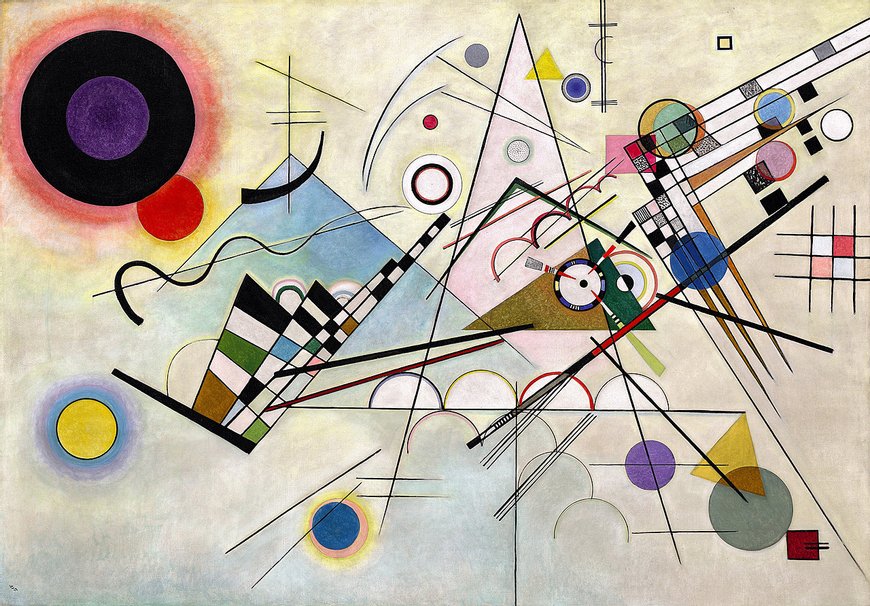
Composition 8
“Color is the keyboard, the eyes are the hammers, the soul is the piano with many strings. The artist is the hand that plays, touching one key or another purposely, to cause vibrations in the soul." 1
Vasily Kandinsky (1866–1944). Composition 8 (Komposition 8), July 1923. Oil on canvas, 55 1/8 x 79 1/8 inches (140 x 201 cm). Solomon R. Guggenheim Museum, New York, Solomon R. Guggenheim Founding Collection, Gift, Solomon R. Guggenheim 37.262. © 2009 Artists Rights Society (ARS), New York/ADAGP, Paris
Introduction
Born in Moscow in 1866, Kandinsky spent his early childhood in Odessa. His parents instilled in him an early love of music that would influence his work, down to the names of his paintings: Improvisations, Impressions, and Compositions.
In 1895 Kandinsky attended an Impressionist exhibition where he saw Monet’s Haystacks at Giverny. He stated, “It was from the catalogue I learned this was a haystack. I was upset I had not recognized it. I also thought the painter had no right to paint in such an imprecise fashion. Dimly I was aware too that the object did not appear in the picture.” Soon after, Kandinsky, who had trained to be a lawyer, left Moscow for Munich to begin his study of art. Kandinsky participated in several of the most influential and controversial art movements of the 20th century, among them the Blue Rider group, which he founded in 1911 with fellow artist Franz Marc. “We thought up the name while sitting at a café table. . . . Both of us were fond of blue things, Marc of blue horses and I of blue riders. So the title suggested itself" (Will Grohmann, Wassily Kandinsky: Life and Work. New York: Harry N. Abrams, 1958, p. 78).
In his memoirs Kandinsky recalls the day in 1910 when he accidentally discovered nonrepresentational art. As he returned home at sunset he was struck as he entered his studio by an “indescribably beautiful painting, all irradiated by an interior light.” He could distinguish only “forms and colors and no meaning.” He soon realized that it was one of his own paintings turned on its side. Soon after he began working on paintings that came to be considered the first totally abstract works in modern art; they made no reference to objects of the physical world and derived their inspiration and titles from music.
In 1912 he published Concerning the Spiritual in Art, the first theoretical treatise on abstraction, which examined the capacity of color to communicate the artist’s innermost psychological and spiritual concerns. His reputation became firmly established in the U.S. through numerous exhibitions and his introduction to Solomon Guggenheim, who became one of his most enthusiastic supporters.
During the spring of 1929, Solomon and Irene Guggenheim accompanied Hilla Rebay, an artist who would later become the first director of the Guggenheim Museum, on a European tour. Introduced to Kandinsky in the artist’s studio in Dessau, Germany, Guggenheim purchased Composition 8, the first of more than 150 works by the artist to enter the collection.
Kandinsky regarded Composition 8 as the high point of his postwar achievement. In this work circles, triangles, and linear elements create a surface of interacting geometric forms. The importance of circles in this painting foreshadows the dominant role they would play in many subsequent works.
Kandinsky evolved an abstract style that reflected the utopian artistic experiments of the Russian avant-garde. The emphasis on geometric forms, promoted by artists such as Kazimir Malevich, sought to establish a universal aesthetic language. Although Kandinsky adopted some of the geometric aspects of Suprematism and Constructivism, his belief in the expressive content of abstract forms alienated him from his Russian colleagues. Kandinsky’s work synthesized Russian avant-garde art with a lyrical abstraction that includes dynamic compositional elements, resembling mountains, sun, and atmosphere that still refer to the landscape. This conflict led him to return to Germany. In 1922 Kandinsky joined the faculty of the Bauhaus where he discovered a more sympathetic environment. He taught there until 1933, when the Nazi government closed the Bauhaus and confiscated 57 of Kandinsky’s works in its purge of “degenerate art.”
Adapted from an essay by Nancy Spector. (Nancy Spector,Guggenheim Museum Collection A to Z. New York: Guggenheim Museum Publications, 2001, p. 387.)
1. Vasily Kandinsky, The Effect of Color, 1911
Preguntas
The title of this painting, Composition 8, suggests an association with music. Imagine that you could hear sounds coming out of this image. What kinds of things might you hear? What type of music does Composition 8 suggest to you? Describe some of the qualities that this musical work would have. Why?
As students view this work, play several selections of different types of pre-recorded music. Ask students to decide which musical work relates most closely to the painting.
Are there aspects of this work that seem to refer to things in the observable world? Are there parts that seem to be completely invented by the artist, or does it seem to be a combination of these two realms? Explain your perceptions.
Describe the way that Kandinsky has used color in this work. Does it convey a particular mood, feeling, sensation, or sense of place? Do you have any personal associations with this palette (combination of colors)?
Kandinsky uses a variety of shapes, lines, and colors to create this painting. List the steps and tools the artist might have used to create this work.
Although Kandinsky named this work Composition 8, generate a list of alternative titles that would be appropriate for this painting.
